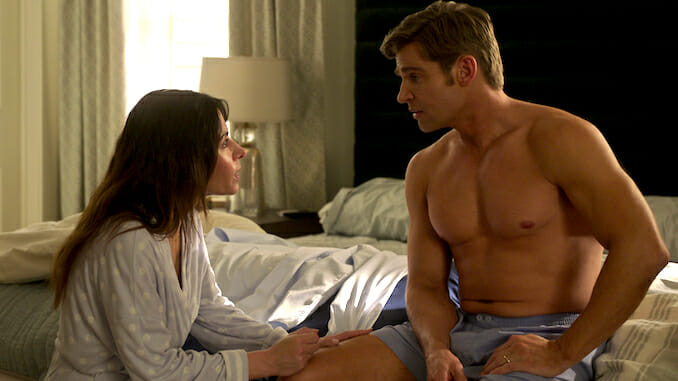Sex/Life‘s Soapiness Suds Away Sexiness on Netflix
Photo Courtesy of Netflix
Netflix’s Sex/Life uses its title as a bludgeon—what you see is what you exactly get on screen. Explicitness abounds. However, the friction that Sex/Life chases more often turns into a rub. As it turns out, both good sex and a good life can bloom when fed full-throated fantasy. But for Sex/Life, its soapy sexuality washes away its potential potency.
The premise of Sex/Life doesn’t stray from stereotypes. The lead, Billie Connelly (Sarah Shahi), stares down a life of monotony while possessing all of the world’s markers of success and comfort: the wealthy and attractive husband (Mike Vogel) with a heart of gold; two beautiful children; a mansion in Greenwich, Connecticut. Her days consist of wandering around her large home in stylish nap dresses, exhausted by child-rearing—albeit with much help from her nanny—wondering who she’s become.
Flashbacks, mediated through overwrought voiceovers of her journaling, work to place the audience back into her Manhattan wild child yesteryears. Temptation, expectation, and frustration braid together the tapestry of Billie’s current sex life, and (if she’s being honest with herself) it’s the same as the toxic past she fantasizes about with exes. In particular, her longing for one incubus of an ex, Adam Demos (Brad Simon), looms as her end-all-be-all. The show’s main point of tension is waiting for Billie’s breaking point: a decision to stand by her current life or shatter it to pieces for a second chance at passion.
And yes, the cliches of the plot cloy the audience endlessly.
Sex/Life executive producer Stacy Rukeyser has toyed with the politics of fantasy before. As a Peabody-winning EP of Lifetime’s UnReal, Rukeyser probed the mirage of commercial fantasy with the world of reality TV. Contrary to this series, UnReal ignites its potential through a fresh POV from the production crew of a thinly veiled version of the Bachelor franchise: the machinations of “behind the scenes” work move to center stage. In Sex/Life, no such strides are taken to reinvigorate the narrative of women’s sexual desire or agency to a similar effect.